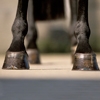|
Advice article filter
|
HoofsGood hoof-care is essential for your horse. Many hoof disorders are the result of insufficient care and/or insufficient exercise. Hoof-care should start in the young foal. Aside from the hereditary factors, the correct footing and the amount of free movement plays an important role in the development of the hoof. The condition of the hoofs will also effect the position of the legs. When the hoofs are in bad shape, the legs will assume an incorrect position. Frequent inspection and - if needed - a treatment by the farrier are prerequisites for healthy hoofs. The daily care consists of picking the hoofs, which removes dirt and debris such as gravel or small rocks. A clean and dry stall can also prevent various hoof disorders. Aside from adequate care, exercise is extremely important for the development of a healthy hoof and hoof joint, because it promotes the blood circulation. This is essential for the transportation of the nutrients that are necessary to keep the hoof healthy, elastic and in optimal condition. Note: hoofs need moisture. Water is essential for hoofs. On the other hand, greasing the hoofs can cause complaints, because it prevents the absorption of water and will dehydrate the hoofs. Spending some time in a wet pasture is a great treatment for hoofs. The hoofs will become elastic and shiny without grease. In case the horse cannot get any pasture time, you can sponge off the hoofs daily. Cracked hoofs Cracked hoofs can be the result of a long period of very dry weather, insufficient exercise (and therefore an insufficient supply of nutrients), shortages in the nutrition or ill-fitting or old shoes. Founder or laminitis Founder is a serious metabolic disorder. It manifests itself as an inflammation of the inner epidermis. The inner epidermis (or corium) is situated behind the thick horn layer of the hoof wall and keeps the coffin bone in place. Symptoms of founder will be present along with lameness — usually in the front feet first. In response to the pain associated with the condition, the horse will shift weight to the back legs, with the front legs extended. This is the typical “founder stance”. The horse will be reluctant to move. An affected horse’s gait is typically short with rapid foot placement, hence the term “walking on eggshells. Founder has several different causes
What can I do? Acute founder
Sensitive to founder?

|

